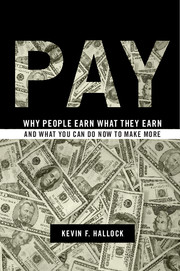Book contents
- Frontmatter
- Contents
- Figures
- Tables
- Acknowledgments
- PART I HOW HARD CAN THIS BE?
- 1 Common Sense, Economics, and HR
- 2 Wages, the Wage Distribution, and Wage Inequality
- 3 The Facts
- 4 The Difference Between Wages and Total Compensation
- PART II HOW ORGANIZATIONS SET PAY STRUCTURE AND WHY
- PART III HOW PEOPLE ARE PAID CAN MEAN AS MUCH AS HOW MUCH THEY ARE PAID
- PART IV WHAT YOU CAN DO TO MAKE MORE AND CONCLUDING COMMENTS
- Notes
- References
- Index
1 - Common Sense, Economics, and HR
How to Pay
from PART I - HOW HARD CAN THIS BE?
Published online by Cambridge University Press: 05 October 2012
- Frontmatter
- Contents
- Figures
- Tables
- Acknowledgments
- PART I HOW HARD CAN THIS BE?
- 1 Common Sense, Economics, and HR
- 2 Wages, the Wage Distribution, and Wage Inequality
- 3 The Facts
- 4 The Difference Between Wages and Total Compensation
- PART II HOW ORGANIZATIONS SET PAY STRUCTURE AND WHY
- PART III HOW PEOPLE ARE PAID CAN MEAN AS MUCH AS HOW MUCH THEY ARE PAID
- PART IV WHAT YOU CAN DO TO MAKE MORE AND CONCLUDING COMMENTS
- Notes
- References
- Index
Summary
Billions of people throughout the world are paid for their work. This book was written to demonstrate why they earn what they earn and, in doing so, to help them understand how they can earn more in the short run and even more in the longer run. There are many ways pay is determined across a wide variety of organizations, from for-profit firms, to nonprofit organizations, to government agencies. By the time you finish reading this book, you will know how a well-run organization takes its overall strategy and converts that into a system for properly paying people. Then you can apply the lessons in the book to your own organization and take actions that can lead you to earn more.
But how difficult can this be? All we are trying to do is consider how and why people are paid the way they are paid. It turns out that this is difficult, but I will try to show you why firms and other organizations do what they do, and with this help, you will hopefully understand how you may be able to better navigate work and consider some things you can do to earn more. Many firms set pay on an ad hoc basis and, frankly, they don't really know what they are doing. Many others have sophisticated systems in place for how to set pay within their organizations. There are many variants to this latter approach, and I highlight these as we go through a basic system that is essentially used by most organizations.
- Type
- Chapter
- Information
- PayWhy People Earn What They Earn and What You Can Do Now to Make More, pp. 3 - 9Publisher: Cambridge University PressPrint publication year: 2012

